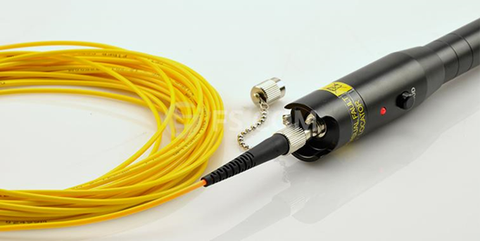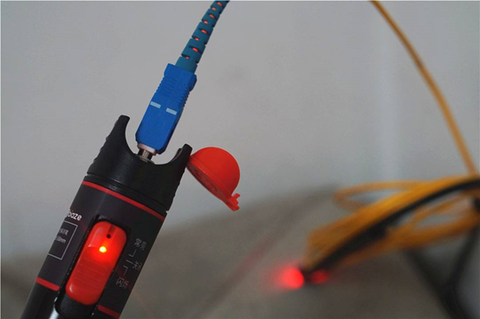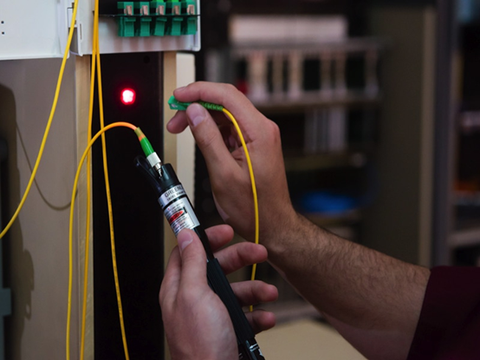What is Visual Fault Locator?
Visual Fault Locator, we usually call it VFL for short, in the optical fiber work, the visual fault locator is mainly responsible for checking whether the optical fiber is damaged and whether there is a breakpoint in the optical fiber.
Its working principle is that it emits stable red light driven by a constant current source, connects with the optical interface and enters the optical fiber, so as to realize the optical fiber fault detection function.

- Why do people choose Visual Fault Locator today? I think there are the following points;
- Professionally speaking, quantum well LD is used as a light source;
- CW and MOD working modes;
- FC, SC, ST general interface;
- Long detection distance;
- The power output is stable;
- Output a red laser visible to the human eye. The penetrating power is extremely strong, and the light leaked from the fault point is still clearly visible through the 3mm PVC layer;
- Nanotechnology multiple electrostatic protection;
- The shell is sturdy and durable, simple and convenient to carry.
- The good function of fiber visual fault locator
- Detect optical fiber connectivity and fault location such as fiber breakage and bending;
- Fault inspection in the blind area of the optical time domain reflectometer OTDR;
- End-to-end fiber identification;
- Mechanical connection point optimization.
- The Application of Visual Fault Locator
- Telecommunication and CATV Engineering and maintenance;
- Construction and maintenance of generic cabling;
- Production and research of optical devices;
- Optical cable inspection in communication industry;
- Other optical fiber works
How to use a Visual fault Locator?
The specific method is that the light emitted by the visual fault locator is red light visible to the naked eye. Therefore, if you place your hand above the end of the fiber and you can see a red light point in your palm, it means that this fiber has no breakpoint fault. On the contrary, if the red light point is not visible, it means that this fiber has a breakpoint fault.


How to choose a visual fault locator ?
When we buy fiber optic visual fault locator, we will often see the following data, 5mw, 10mw, 20mw, 30mw. So, what does mw mean here?
In fact, mw is an optical unit. We call it the optical power value. This is used to measure the intensity of the emitted light. In the Visual fault locator, we call it the optical power output value. We all know that light propagates in a medium and is gradually weakened, so how to choose a Visual Fault locator? Mainly refer to the following points;
- Subjectively, it depends on the length of the fiber you measure. Usually, the longer the length of the fiber, the higher the optical power output value of the Visual fault locator. That is, the larger the mw value.
- Secondly, it depends on the wavelength of the measuring fiber.
- Objectively, because the optical power output value has several levels, such as 5mw, 10mw, 20mw, 30mw. The distance they can theoretically measure is roughly as follows;
|
mw |
5mw |
10mw |
20mw |
30mw |
50mw |
100mw |
|
Testing distance |
>=5km |
>=10km |
>=20km |
>=30km |
>=50km |
>=100km |
What is pen type Visual Fault Locator ?
As the name suggests, this visual fault locator looks like a pen. At present, this kind of visual fault locator is more popular in the market. There are mainly the following reasons;
- Easy to carry, small body
- Compared with the traditional visual fault locator, the measurement advantages are not weakened
- People are more willing to use this small body with other optical fiber measurement tools.

BAUDCOM offers pen type visual fault locator designed for field personnel who need an efficient, cost-effective tool for fiber tracing, fiber routing, and optical network continuity checks. It finds breaks, bad connections, bends or cracks in fiber optic cables; it can find faults in OTDR dead zones for end-to-end visual fiber identification. Welcome to buy!
Related video

